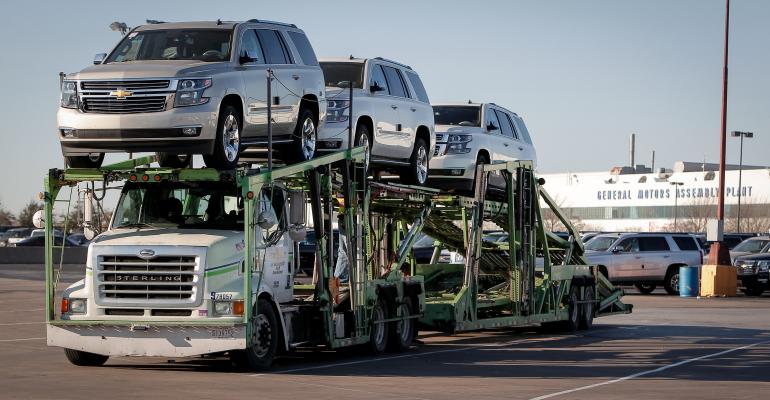General Motors CEO Mary Barra says the automaker has room in its large-truck assembly plants to pump out more volume to meet brisk demand, which provided a surge in its first-quarter financial results, without adding an additional facility.
“Our primary focus is on breaking bottlenecks, not only in our plants but also in supplier
plants to make sure we are driving maximum capacity without installing new brick and mortar,” Barra tells journalists and analysts in a conference call to discuss GM’s robust, $945 million first-quarter profit.
“There is still a lot we can do there, but also (work) to get the mix to exactly what customers are looking for. We have a dedicated team that works on that. We’ve already made tremendous progress. It’s a breaking-bottlenecks strategy,” she says.
Low fuel prices, a rebounding economy and strong consumer confidence are driving demand for GM’s large trucks. Sales of the automaker’s large pickups, SUVs and luxury SUVs combined soared 21.6% in the first quarter to 226,617 units from 186,308 last year, according to WardsAuto data.
GM’s share of the large-truck segment swelled to an industry-leading 41.1% from 37.4% in the same period and the vehicles now account for 33.1% of its sales compared with 28.7% year-ago.
With redesigned models in the market and production now at full-line run rates, the automaker is booking dividends. The average transaction price on large pickups in the first quarter grew $1,067 to $39,810, while the ATP on large SUVs jumped $6,753 to $59,437 and large luxury SUVs expanded $14,152 to $83,160.
The uptick in sales and ATPs rallied GM’s first-quarter returns in North America to $2.2 billion before interest and taxes, compared with $600 million in like-2014. Results for the first quarter of 2014 included $1.3 billion in recall-related costs.
GM now finds itself swimming in truck profits but at the same time resisting the temptation to add new capacity with the near-certainty of rising fuel prices ahead and ever-tightening federal fuel-economy and emissions regulations accruing.
The automaker does have an idled large SUV assembly plant in Janesville, WI, dark since April 2009. Chief Financial Officer Chuck Stevens reiterates there are no notions of firing up another assembly site.
GM built 299,202 large trucks in first-quarter 2015, up 17.4% from 254,870 last year.
“We’ve got opportunities from an overtime perspective, and we will continue to look at efficiency,” he says on the conference call.
“Our intention is not to add fixed capacity investment, such as brick and mortar,” Stevens continues. “It is to optimize (output), where we can, in the supply base and (GM) assembly. That’s what we’ve been doing over the last few years. No brick and mortar. We add shifts, we continue to drive line-rate efficiency.”
GM executives also told WardsAuto last month that weakening demand in markets such as the Middle East and Canada have eased to allow more units into the U.S.

Stevens expects the favorable mix between trucks and cars to continue as the year unfolds, although the January-March period likely would be the high point. He thinks GM’s move into new segments, such as midsize pickups and compact CUVs will be one element to moderate large-truck sales. Pricing looks favorable, he adds.
“We would like to hold some of that (truck pricing), but it is early in the year,” Stevens says.
Barra also says on the call that her management team has no intentions of pursuing a merger sought in the financial press by FCA US CEO Sergio Marchionne. Marchionne in recent months has been lobbying for industry consolidation to drive up scale, lower costs and raise automaker stock price valuations.
Barra says her go-forward plan is fixed and GM is not a candidate.
“We laid out a comprehensive (corporate) plan that takes us through the next decade,” Barra says. “There is tremendous opportunity for us within the business, as we look at efficiency measures and as we look at truly achieving the scale we should have because we are already in that top tier of the auto industry.
“We have a very well-articulated plan, we’re in the middle of executing that and we’re not going to entertain anything that will distract us from accomplishing that,” she says.
GM and the former Fiat S.p.A. have a rocky history anyway. The pair had an alliance a decade ago that went sour and cost GM $2 billion.
As for GM’s financial results in the most recent quarter, Barra calls it a “solid performance” and “in line with our expectations.”
Revenue fell about 5% to $35.7 billion, affected by unfavorable currency exchanges and sales declines in South America and Russia. GM plans to cease production and nearly all of its sales in Russia, an action that resulted in a $400 million charge in period.





